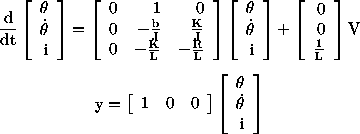System Equations
Design Requirements
Matlab Representation and Open-Loop Response
Physical Setup
A common actuator in control systems is the DC motor. It directly provides rotary motion and, coupled with wheels or drums and cables, can provide transitional motion. The electric circuit of the armature and the free body diagram of the rotor are shown in the following figure:

For this example, we will assume the following values for the physical parameters. These values were derived by experiment from an actual motor in Carnegie Mellon's undergraduate controls lab.
* damping ratio of the mechanical system (b) = 3.5077E-6 Nms
* electromotive force constant (K=Ke=Kt) = 0.0274 Nm/Amp
* electric resistance (R) = 4 ohm
* electric inductance (L) = 2.75E-6 H
* input (V): Source Voltage
* output (theta): position of shaft
* The rotor and shaft are assumed to be rigid
System Equations
The motor torque, T, is related to the armature current, i, by a constant factor Kt. The back emf, e, is related to the rotational velocity by the following equations:

In SI units (which we will use), Kt (armature constant) is equal to Ke (motor constant).
From the figure above we can write the following equations based on Newton's law combined with Kirchhoff's law:

1. Transfer Function
Using Laplace Transforms the above equations can be expressed in terms of s.


By eliminating I(s) we can get the following transfer function, where the rotating speed is the output and the voltage is an input.

However during this example we will be looking at the position, as being the output. We can obtain the position by integrating Theta Dot, therefore we just need to divide the transfer function by s.

2. State Space
These equations can also be represented in state-space form. If we choose motor position, motor speed, and armature current as our state variables, we can write the equations as follows:

Design requirements
We will want to be able to position the motor very precisely, thus the steady-state error of the motor position should be zero. We will also want the steady-state error due to a disturbance, to be zero as well. The other performance requirement is that the motor reaches its final position very quickly. In this case, we want it to have a settling time of 40ms. We also want to have an overshoot smaller than 16%.
If we simulate the reference input (R) by a unit step input, then the motor speed output should have:
